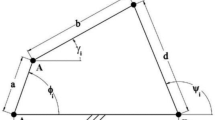Abstract
The Latin hypercube design (LHD) is a popular choice of experimental design when computer simulation is used to study a physical process. In this paper, we propose some methods for constructing nearly orthogonal Latin hypercube designs (NOLHDs) with 2, 4, 8, 12, 16, 20 and 24 factors having flexible run sizes. These designs can be very useful when orthogonal Latin hypercube designs (OLHDs) of the needed sizes do not exist.
Similar content being viewed by others
References
Ai MY, He YZ, Liu SM (2012) Some new classed of orthogonal Latin hypercube designs. J Stat Plan Inference 142:2809–2818
Bingham D, Sitter RR, Tang B (2009) Orthogonal and nearly orthogonal designs for computer experiments. Biometrika 96:51–65
Butler NA (2001) Optimal and orthogonal Latin hypercube designs for computer experiments. Biometrika 88:847–857
Cioppa TM, Lucas TW (2007) Efficient nearly orthogonal and spaced-filling Latin hypercubes. Technometrics 49:45–55
Fang KT, Li R, Sudjianto A (2006) Design and modeling for computer experiments. Chapman and Hall/CRC, New York
Georgiou SD (2009) Orthogonal Latin hypercube designs from generalized orthogonal designs. J Stat Plan Inference 139:1530–1540
Georgiou SD, Efthimiou I (2014) Some classes of orthogonal Latin hypercube designs. Stat Sin 24:101–120
Georgiou SD, Koukouvinos C, Liu MQ (2014) U-type and column-orthogonal designs for computer experiments. Metrika. doi:10.1007/s00184-014-0486-8
Georgiou SD, Stylianou S (2011) Block-circulant matrices for constructing optimal Latin hypercube designs. J Stat Plan Inference 141:1933–1943
Georgiou SD, Stylianou S (2012) Corrigendum to: Block-circulant matrices for constructing optimal Latin hypercube designs. J Stat Plan Inference 142:1623–1623
Geramita AV, Seberry J (1979) Orthogonal designs: quadratic forms and Hadamard matrices. Marcel Dekker, New York
Hernandez AS, Lucas TW, Carlyle M (2012) Constructing nearly orthogonal Latin hypercubes for any nonsaturated run-variable combination. ACM Trans Model Comput Simul 22:1–17
Kharaghani H (2000) Arrays for orthogonal designs. J Comb Des 8:166–173
Lin CD, Bingham D, Sitter RR, Tang B (2010) A new and flexible method for constructing designs for computer experiments. Ann Stat 38:1460–1477
Lin CD, Mukerjee R, Tang B (2009) Construction of orthogonal and nearly orthogonal Latin hypercubes. Biometrika 96:243–247
McKay MD, Beckman RJ, Conover WJ (1979) A comparison of three methods for selecting values of input variables in the analysis of output from a computer code. Technometrics 16:239–245
Owen AB (1994) Controlling correlations in Latin hypercube samples. J Am Stat Assoc 89:1517–1522
Pang F, Liu MQ, Lin DKJ (2009) A construction method for orthogonal Latin hypercube designs with prime power levels. Stat Sin 19:1721–1728
Steinberg M, Lin DKJ (2006) A construction method for orthogonal Latin hypercube designs. Biometrika 93:279–288
Sun FS, Liu MQ, Lin DKJ (2009) Construction of orthogonal Latin hypercube designs. Biometrika 96:971–974
Sun FS, Liu MQ, Lin DKJ (2010) Construction of orthogonal Latin hypercube designs with flexible run sizes. J Stat Plan Inference 140:3236–3242
Sun FS, Pang F, Liu MQ (2011) Construction of column-orthogonal designs for computer experiments. Sci China Math 54:2683–2692
Tang B (1998) Selecting Latin hypercubes using correlation criteria. Stat Sin 8:965–977
Viana FAC, Venter G, Balabanov V (2010) An algorithm for fast optimal Latin hypercube design of experiments. Int J Numer Methods Eng 82:135–156
Yang JY, Liu MQ (2012) Construction of orthogonal and nearly orthogonal Latin hypercube designs from orthogonal designs. Stat Sin 22:433–442
Yin YH, Liu MQ (2013) Orthogonal Latin hypercube designs for Fourier polynomial models. J Stat Plan Inference 143:307–314
Ye KQ (1998) Orthogonal column Latin hypercubes and their application in computer experiments. J Am Stat Assoc 93:1430–1439
Acknowledgments
The authors thank the Editor and one anonymous referee for their valuable comments. Liu’s work is partially supported by the National Natural Science Foundation of China (Grant No. 11271205), the Specialized Research Fund for the Doctoral Program of Higher Education of China (Grant No. 20130031110002), and the “131” Talents Program of Tianjin.
Author information
Authors and Affiliations
Corresponding author
Rights and permissions
About this article
Cite this article
Efthimiou, I., Georgiou, S.D. & Liu, MQ. Construction of nearly orthogonal Latin hypercube designs. Metrika 78, 45–57 (2015). https://doi.org/10.1007/s00184-014-0489-5
Received:
Published:
Issue Date:
DOI: https://doi.org/10.1007/s00184-014-0489-5




